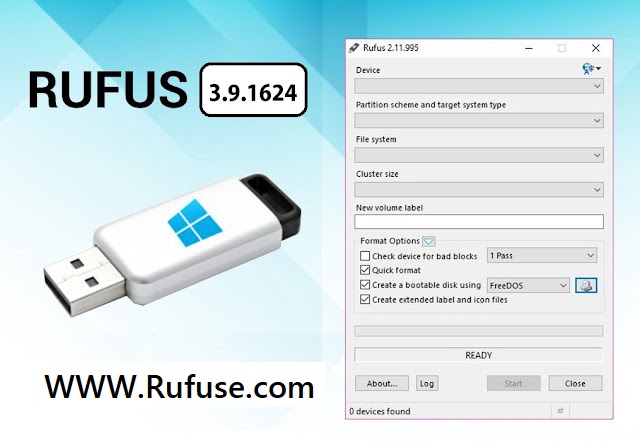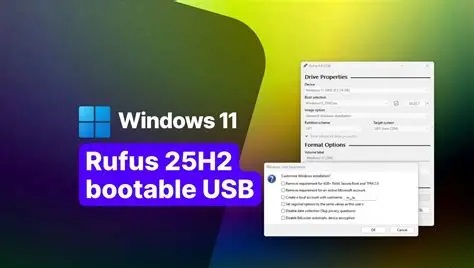Rufus has firmly established itself as an indispensable tool in the tech enthusiast’s arsenal. This lightweight, open-source application excels at formatting and creating bootable USB drives, a critical task for installing operating systems like Windows, Linux, or for running low-level utilities. Its speed, reliability, and simplicity have made it a favorite over bulkier alternatives, especially when you need a quick and dependable solution for system administration or recovery.
The process of obtaining Rufus is straightforward, but knowing how to do so safely and efficiently is paramount. With countless websites offering software downloads, many are laden with unwanted bundled software, misleading ads, or, worse, malicious code. This guide is designed to walk you through the entire process, from identifying the official source to creating your first bootable USB, ensuring you get the authentic, latest version of Rufus without any compromises to your system’s security.
Understanding the correct procedure is not just about avoiding malware; it’s about leveraging the full potential of the tool. By following the steps outlined in this comprehensive article, you will be equipped to handle tasks like creating installation media for a new PC build, reviving an old computer with a lightweight Linux distribution, or creating a persistent USB drive. Let’s begin by locating the only source you should ever need: the official Rufus website.
Understanding Rufus and Its Key Uses
Rufus, which stands for “Reliable USB Formatting Utility, with Source,” is a free and open-source application for Microsoft Windows. Its primary function is to format and create bootable USB flash drives. While this might sound like a niche task, its applications are vast and incredibly useful for both casual users and IT professionals. The program is remarkably efficient, often completing tasks much faster than the official media creation tools provided by operating system developers.
The utility shines in scenarios where you need to install an operating system onto a computer that lacks one or where the existing OS is corrupted. Whether you are building a new gaming PC and need to install Windows 11, or repurposing an old laptop with a lightweight Linux OS, Rufus is the tool for the job. It can also be used to flash a BIOS or other firmware from a USB drive, and to run low-level system diagnostics tools that operate outside of the main operating system.
One of the key advantages of Rufus is its support for a wide array of disk partition schemes and target system types. It can handle everything from older BIOS-based systems to modern UEFI machines, and it supports various file systems like FAT32, NTFS, and UDF. This flexibility ensures that regardless of the age or specification of the computer you are working on, Rufus can be configured to create a compatible bootable drive, making it a truly universal tool.
Finding the Official Rufus Website
The most critical step in downloading Rufus is ensuring you acquire it from the official source to avoid counterfeit software that can harm your computer. The genuine Rufus project is hosted on GitHub, a reputable platform for open-source software development. The official website you should visit is Rufuse.com. This domain is the primary and authoritative home for the application, maintained by the developer, Pete Batard.
Be highly cautious of other websites that claim to offer Rufus downloads. Third-party download portals often wrap the original installer in their own packaging that includes potentially unwanted programs (PUPs), adware, or toolbars. A telltale sign of the official site is its clean, minimalist design, devoid of flashy banners or deceptive “Download” buttons that lead to other software. The real download link is prominently displayed and straightforward.
Once on the official website, you will immediately see the latest version number, the release date, and a clear download link. The site also provides a detailed changelog, so you can see what improvements or bug fixes have been made in the latest release. For users who require a portable version that doesn’t require installation, the site offers both an installer executable (.exe) and a portable executable. Bookmarking this page is the best way to guarantee you always get the authentic software.
Step-by-Step Download Guide
Navigating the download process correctly is the key to a safe and successful installation. Begin by opening your preferred web browser—be it Chrome, Firefox, Edge, or another—and navigating to the official URL: http://rufuse.com/. The page will load quickly, presenting you with the essential information about the current version. Your browser and operating system will be automatically detected, presenting you with the appropriate download link.
You will be presented with two primary download options: the installer version and the portable version. The installer version (e.g., rufus-4.xx.exe) is a standard application that will be installed on your Windows system. The portable version (e.g., rufus-4.xxp.exe) can be run directly from a USB drive or folder without installing anything on the host computer, which is ideal for tech support scenarios.
- Step 1: Click on the link that matches your preference (e.g., “Rufus 4.xx Portable”).
- Step 2: Your browser will typically ask you to confirm the download. Save the file to a easily accessible location, such as your
Downloadsfolder or directly to your desktop. - Step 3: Once the download is complete, navigate to the folder containing the file. You are now ready to run Rufus.
System Requirements and Compatibility
Before proceeding, it is prudent to verify that your computer meets the necessary requirements to run Rufus smoothly. Fortunately, the requirements are minimal, making it accessible for almost any functioning Windows machine. Rufus is designed to be a lean application that performs a specific task with maximum efficiency, requiring very little from the host system.
The primary requirement is having a compatible version of Windows installed. Rufus works on Windows 8, Windows 10, and Windows 11. It is also compatible with Windows 7, though support for older operating systems may not include the latest features. The application itself requires negligible disk space, often less than 5 MB, and a similarly small amount of RAM to operate, meaning system resources are never a concern.
The only other essential requirement is having a USB flash drive that you intend to make bootable. The drive should have sufficient capacity for the operating system image you plan to use; for example, a modern Windows 11 ISO file requires at least an 8 GB drive, though a 16 GB or larger drive is recommended for flexibility. Beyond these basics, no special hardware or software is needed, ensuring broad compatibility across a vast range of computers.
Creating Your First Bootable USB Drive
With Rufus successfully downloaded, the exciting part begins: creating a bootable USB drive. This process will prepare the drive to install an operating system. First, insert the USB flash drive you wish to use into an available port on your computer. It is crucial to back up any important data on the drive beforehand, as the Rufus process will completely erase all existing content on the device.
Launch Rufus by double-clicking the executable file you downloaded. The application window will open, presenting a simple yet powerful interface. The top section, “Device,” will automatically detect your inserted USB drive. Below that, you will see several key options that need to be configured correctly for your specific task, including the boot selection, partition scheme, and target system type.
- Select the ISO Image: Under “Boot selection,” choose “Disk or ISO image” and click “SELECT” to browse for your downloaded OS ISO file.
- Configure Partition Scheme: For modern computers (post-2015), typically set “Partition scheme” to “GPT” and “Target system” to “UEFI (non-CSM).”
- Start the Process: Leave other options at their defaults unless you have specific needs, then click “START.” Rufus will warn you that all data will be destroyed; confirm to begin.
Troubleshooting Common Download and Usage Issues
Even with a straightforward tool like Rufus, you may occasionally encounter hurdles. A common issue during download is the browser or antivirus software blocking the executable file. This is often a false positive because Rufus performs low-level disk operations, which security software can flag as suspicious. If this happens, check your browser’s downloads bar or security settings to allow the file, and you may need to temporarily disable your antivirus or add an exception.
If Rufus fails to recognize your USB drive, try a few simple steps. First, unplug the drive and plug it into a different USB port, preferably one directly on the motherboard rather than a front-panel or hub port. If it remains undetected, check the Windows Disk Management tool to see if the drive is visible there; it might need to be initialized or could be failing. Using a different brand or model of USB drive is a reliable troubleshooting step.
Errors during the creation of the bootable drive often relate to the ISO file or the drive itself. If the process fails or the resulting drive doesn’t boot, the ISO file may be corrupted. Redownload the OS image from its official source. Alternatively, the USB drive could be faulty. Try the process again with a different flash drive. Also, ensure you have selected the correct partition scheme (MBR for older BIOS systems, GPT for newer UEFI systems) for the computer you are targeting.
Why Rufus is Free and Legal to Download
A common and valid question is how Rufus can be offered for free and whether it is legal to use. Rufus is free because it is an open-source project released under the GNU General Public License (GPLv3). This license grants users the freedom to run, study, share, and modify the software. The developer, Pete Batard, contributes to the project voluntarily, and the software is distributed without any cost or hidden fees.
There are no subscription models, premium tiers, or advertisements within Rufus. It is genuinely freeware. The legality of downloading and using Rufus is unequivocal; it is perfectly legal. You are not violating any copyright laws by using it to create bootable media for operating systems you own or have the right to install. The tool itself is simply a utility, much like a file archiver, and its legality in use depends on the software you are installing with it.
The open-source nature of Rufus also contributes to its security and reliability. Because the source code is publicly available for scrutiny, security experts and developers can audit it for potential vulnerabilities or malicious code. This transparency builds trust and is a hallmark of reputable free software. You can use Rufus with confidence, knowing it is both a legal and secure application for your needs.
Conclusion
Successfully obtaining and utilizing the latest version of Rufus is a simple yet vital skill for anyone involved in computer maintenance or setup. By adhering to the guidance of sourcing the application exclusively from its official website, you guarantee a secure and authentic experience, free from the risks associated with third-party download sites. The step-by-step process for creating a bootable USB drive demystifies a powerful technical task, empowering you to install operating systems, run diagnostics, and recover systems with confidence. Remember that Rufus is a legally free, open-source tool, a testament to the value of collaborative development. With this knowledge, you are now equipped to handle a wide range of computing tasks efficiently and safely, making Rufus an essential component of your digital toolkit.



